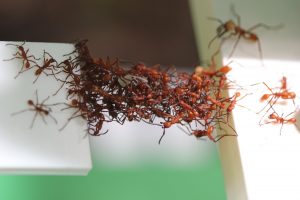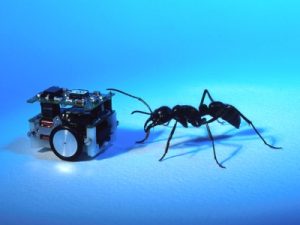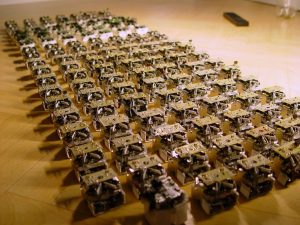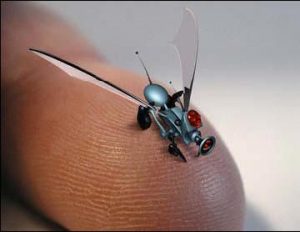Swarm intelligence is the idea of coordinating massive numbers of individual technology entities to work together. It is a fundamental concept in IT that has been useful and interesting, as well as a bit threatening, throughout the development of modern technological progress.
It all goes back to the birds and the bees. Fish too. Even ants. It goes to the great many organisms that amplify their group intelligence by forming flocks, schools, shoals, colonies, and swarms. Across countless species, nature show us that social creatures, when working together as unified systems, can outperform the vast majority of individual members when solving problems and making decisions. Scientists call this “Swarm Intelligence” and it proves the old adage – many minds are better than one.

As a group, simple creatures following simple rules can display a surprising amount of complexity, efficiency, and even creativity. Known as swarm intelligence, this trait is found throughout nature, but researchers have recently begun using it to transform various fields such as robotics, data mining, medicine, and blockchains.
Ants, for example, can only perform a limited range of functions, but an ant colony can build bridges, create superhighways of food and information, wage war, and enslave other ant species—all of which are beyond the comprehension of any single ant. Likewise, schools of fish, flocks of birds, beehives, and other species exhibit behavior indicative of planning by a higher intelligence that doesn’t actually exist.
How does a swarm live? How does a swarm communicate? A unique “life” takes shape when a swarm forms, and it has everything to do with spatial intelligence. When observing swarms, we start to notice certain principles:
- Work division
- Collective behaviors
- Navigation
- Communication
- Self-organization
What about us humans? We didn’t evolve the natural ability to form a Swarm Intelligence, for we lack the subtle connections that other species use to establish tight feedback-loops among members. Fish detect tremors in the water around them. Bees use high speed vibrations. Birds detect motions propagating through the flock. But now, with high-speed networking technology, we human can connect with each other from anywhere in world. We just need the the right technology to turn those connections into real-time system with closed-loop feedback among members.
What If Humans Are the Ants?

When viewed from a great height, a blockchain performs eerily like an ant colony in that it will naturally find the most efficient way to move vast amounts of information.
Miners compete with each other to perform the complex calculations necessary to add another block, for which the winner is rewarded with the blockchain’s native currency and agreed-upon fees. Of course, the miner with the more powerful computers is more likely to win the reward, thereby empowering the winner’s ability to mine and receive even more rewards. Over time, fewer and fewer miners are going to exist, as the winners are able to more efficiently shoulder more of the workload, in much the same way that ants build superhighways.
Further, a company called Unanimous AI has developed algorithms that allow humans to collectively make predictions. So far, the AI algorithms and their human participants have made some astoundingly accurate predictions, such as the first four winning horses of the Kentucky Derby, the Oscar winners, the Stanley Cup winners, and others. The more people involved in the swarm, the greater their predictive power will be.
The Michael Crichton swarm is an example of the underlying idea of swarm intelligence as mimicking natural science. Experts give examples like the flocking of birds, the colony behavior of ants, schools of fish and the proliferation of bacteria as natural systems that provide models that swarm intelligence could emulate. Others talk about stochastic processes that may model swarm intelligence for the purposes of better understanding how concrete applications of swarm intelligence IT would work.
Today scientists are thinking about general-purpose uses of swarm intelligence, as well as more specific applications to defense systems and other uses in other industries. For example, some theorize that a smart troupe of swarm technologies could be able to help with the devastating problem of seeded land mines in previously war-torn areas. In general, the idea of swarm intelligence dovetails with the idea of vast networks of loosely coupled technologies, such as in the internet of things model that is becoming so prominent in the development of consumer technologies
Translating it into AI

So how can this be translated into practice for autonomous cars? Cars are not the same as insects after all. They will not, for example, tell each other where there are ample sources of food.
Cars will instead, it is envisaged, ‘communicate’ about traffic congestion and warn against other problems. Heavily laden trucks will know when it is approaching a hill thanks to digital maps and satellite navigation. The trucks’ AI will the be able to calculate that its journey will be slowed down.
This can then relay this information to other vehicles in the local vicinity and tell them to promptly overtake. The truck will also attempt to make this process as easy as possible.
Other information can also be sent electronically to cars. This could include from traffic lights that can’t necessarily be ‘seen’ yet by the vehicle. Any information that will help autonomous cars get an ‘appreciation’ for the driving conditions in the future will help reduce traffic issues.
However, while logistical systems like these are being implemented, it still lacks a swarm ‘mentality’, per se.
Military researchers are especially concerned about recent breakthroughs in swarm intelligence that could enable “swarm warfare” for asymmetric assaults against major weapons platforms, such as aircraft carriers. The accelerating speed of computer processing, along with rapid improvements in the development of autonomy-increasing algorithms also suggests that it may be possible for the military to more quickly perform a wider range of functions without needing every individual task controlled by humans.

Let’s collect lessons from nature, insights from humans and the unified benefits of intelligent systems and create something smarter than ourselves. These intelligent systems — things smarter than ourselves — appear to think and act. The algorithms, robotics and systems are only a piece of the system we’ll create. Instead of creating and designing complete intelligence systems, maybe we should apply simple rules to form collections of behaviors or swarms.
These swarms could respond by connecting real-time human insights into more intelligent systems with morals, values, emotions and empathy. Swarm intelligence won’t be something you watch on a Ted Talk. Swarm intelligence is going to be a feeling that transcends nature through a collision of the digital and physical worlds.
Tomorrow’s systems will be designed with swarm intelligence and spatial judgment.
Conclusion
Swarm Intelligence-based techniques can be used in a number of applications. The U.S. military is investigating swarm techniques for controlling unmanned vehicles. The European Space Agency is thinking about an orbital swarm for self-assembly and interferometry. NASA is investigating the use of swarm technology for planetary mapping. A 1992 paper by M. Anthony Lewis and George A. Bekey discusses the possibility of using swarm intelligence to control nanobots within the body for the purpose of killing cancer tumors.
As we capitalize on the military applications of Artificial Intelligence, there is a risk that human decision-making may no longer be involved in the use of lethal force. In general, Artificial Intelligence could indeed be disruptive to our human society by replacing the need for human control, but machines do not have to replace humans in the command and control of cognitive tasks, particularly in military contexts. We need to figure out how to keep humans in the loop. This area of research would be a fruitful one for the human systems community to undertake in the future.

